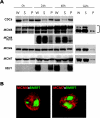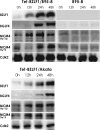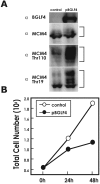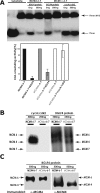Phosphorylation of MCM4 at sites inactivating DNA helicase activity of the MCM4-MCM6-MCM7 complex during Epstein-Barr virus productive replication
- PMID: 17005684
- PMCID: PMC1617282
- DOI: 10.1128/JVI.00678-06
Phosphorylation of MCM4 at sites inactivating DNA helicase activity of the MCM4-MCM6-MCM7 complex during Epstein-Barr virus productive replication
Abstract
Induction of Epstein-Barr virus (EBV) lytic replication blocks chromosomal DNA replication notwithstanding an S-phase-like cellular environment with high cyclin-dependent kinase (CDK) activity. We report here that the phosphorylated form of MCM4, a subunit of the MCM complex essential for chromosomal DNA replication, increases with progression of lytic replication, Thr-19 and Thr-110 being CDK2/CDK1 targets whose phosphorylation inactivates MCM4-MCM6-MCM7 (MCM4-6-7) complex-associated DNA helicase. Expression of EBV-encoded protein kinase (EBV-PK) in HeLa cells caused phosphorylation of these sites on MCM4, leading to cell growth arrest. In vitro, the sites of MCM4 of the MCM4-6-7 hexamer were confirmed to be phosphorylated with EBV-PK, with the same loss of helicase activity as with CDK2/cyclin A. Introducing mutations in the N-terminal six Ser and Thr residues of MCM4 reduced the inhibition by CDK2/cyclin A, while EBV-PK inhibited the helicase activities of both wild-type and mutant MCM4-6-7 hexamers, probably since EBV-PK can phosphorylate MCM6 and another site(s) of MCM4 in addition to the N-terminal residues. Therefore, phosphorylation of the MCM complex by redundant actions of CDK and EBV-PK during lytic replication might provide one mechanism to block chromosomal DNA replication in the infected cells through inactivation of DNA unwinding by the MCM4-6-7 complex.
Figures






Similar articles
-
Site-specific phosphorylation of MCM4 during the cell cycle in mammalian cells.FEBS J. 2006 Mar;273(6):1224-39. doi: 10.1111/j.1742-4658.2006.05146.x. FEBS J. 2006. PMID: 16519687
-
Levels of MCM4 phosphorylation and DNA synthesis in DNA replication block checkpoint control.J Struct Biol. 2004 Apr-May;146(1-2):234-41. doi: 10.1016/j.jsb.2003.11.027. J Struct Biol. 2004. PMID: 15037254
-
Latent and lytic Epstein-Barr virus replication strategies.Rev Med Virol. 2005 Jan-Feb;15(1):3-15. doi: 10.1002/rmv.441. Rev Med Virol. 2005. PMID: 15386591 Review.
-
Phosphorylation of Mcm4 at specific sites by cyclin-dependent kinase leads to loss of Mcm4,6,7 helicase activity.J Biol Chem. 2001 Sep 14;276(37):34428-33. doi: 10.1074/jbc.M104480200. Epub 2001 Jul 13. J Biol Chem. 2001. PMID: 11454864
-
Lytic cycle switches of oncogenic human gammaherpesviruses.Adv Cancer Res. 2007;97:81-109. doi: 10.1016/S0065-230X(06)97004-3. Adv Cancer Res. 2007. PMID: 17419942 Review.
Cited by
-
Epstein-Barr virus BGLF4 kinase downregulates NF-κB transactivation through phosphorylation of coactivator UXT.J Virol. 2012 Nov;86(22):12176-86. doi: 10.1128/JVI.01918-12. Epub 2012 Aug 29. J Virol. 2012. PMID: 22933289 Free PMC article.
-
Maribavir inhibits epstein-barr virus transcription in addition to viral DNA replication.J Virol. 2009 Dec;83(23):12108-17. doi: 10.1128/JVI.01575-09. Epub 2009 Sep 16. J Virol. 2009. PMID: 19759127 Free PMC article.
-
Partial MCM4 deficiency in patients with growth retardation, adrenal insufficiency, and natural killer cell deficiency.J Clin Invest. 2012 Mar;122(3):821-32. doi: 10.1172/JCI61014. Epub 2012 Feb 22. J Clin Invest. 2012. PMID: 22354167 Free PMC article.
-
Biochemical characterization of Plasmodium falciparum parasite specific helicase 1 (PfPSH1).FEBS Open Bio. 2019 Nov;9(11):1909-1927. doi: 10.1002/2211-5463.12728. Epub 2019 Sep 30. FEBS Open Bio. 2019. PMID: 31469232 Free PMC article.
-
SUMO binding by the Epstein-Barr virus protein kinase BGLF4 is crucial for BGLF4 function.J Virol. 2012 May;86(10):5412-21. doi: 10.1128/JVI.00314-12. Epub 2012 Mar 7. J Virol. 2012. PMID: 22398289 Free PMC article.
References
-
- Aparicio, O. M., D. M. Weinstein, and S. P. Bell. 1997. Components and dynamics of DNA replication complexes in S. cerevisiae: redistribution of MCM proteins and Cdc45p during S phase. Cell 91:59-69. - PubMed
-
- Bailis, J. M., and S. L. Forsburg. 2004. MCM proteins: DNA damage, mutagenesis and repair. Curr. Opin. Genet. Dev. 14:17-21. - PubMed
-
- Bell, S. P., and A. Dutta. 2002. DNA replication in eukaryotic cells. Annu. Rev. Biochem. 71:333-374. - PubMed
Publication types
MeSH terms
Substances
LinkOut - more resources
Full Text Sources
Molecular Biology Databases
Research Materials
Miscellaneous

